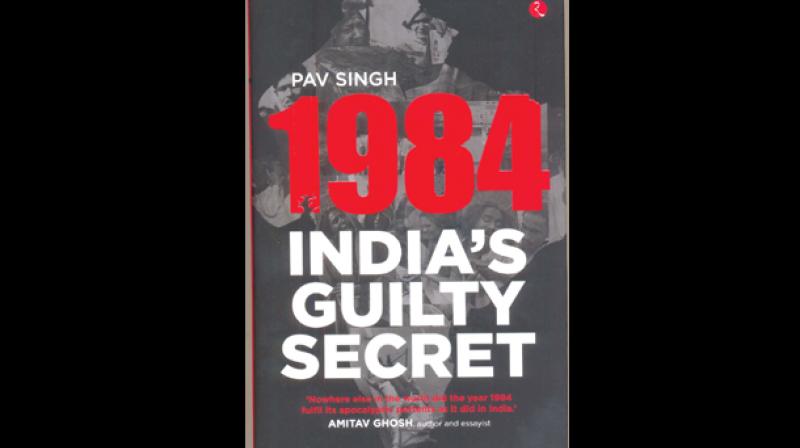Book review: Grim reminder of majority-minority relationship going in wrong direction
Pav Singh leaves the reader with an equally thought-provoking issue, on how any majority in a civilised society today should treat its minorities.

Chennai: The grim and unimaginably tortuous edges of the 'planned' atrocities against the Sikh community people in the national capital of New Delhi in the aftermath of the assassination of former Prime Minister Indira Gandhi on October 31, 1984, even 33 years hence are still a shrivelling, salutary and humbling reminder on how any minority community could crumble overnight.
Researcher and writer Pav Singh, son of Punjabi immigrants in England, who spent a full year in India researching various aspects of the '1984 pogrom' - the author says his own extended family members in Delhi had narrowly escaped those three catastrophic days of killing, arson and rape of innocent men, women and children until the Army “eventually arrived on November 3” that year to restore some semblance of order - has braved an extremely painful study to essay.
The author's terrain is not just about revisiting an extremely traumatic phase of an otherwise historically chivalrous, very patriotic, energetic, enterprising and truly international community such as the Sikhs who make India proud wherever they are. It is doubly burdened by the near psychological impossibility of not having to reopen old scars, wounds that may still continue to fester.
This is what makes Pav Singh's latest work an extremely difficult piece of writing, combining factually co-relatable reportage with the wider and deeper issues, trends and events, a familiarity with which is key to understanding of the 1984 colossal human tragedy, which the author quotes the celebrated writer Amitav Ghosh as having termed the coming true of an “apocalyptic portents”.
That phase of post-Independent India, which coursed through over long years post-partition, from the rough and edgy equations between the Congress and Akali Dal in Punjab, the linguistic reorganisation that set apart a Hindu-majority Haryana from an earlier composite Punjab which had lost much of its fertile agriculture area to Pakistan due to the Partition, the migration of their poorer brothers and sisters as refugees without a paisa to Delhi, the militancy in Punjab in the early 1980s', the opacity of the responses of the then political establishment in Delhi that led to the rise of Bhindranwale, June 1984 'Operation Blue Star' that saw the Army storming the holiest of Sikh shrines, right up to the very tragic assassination of Mrs Indira Gandhi in the hands of her own security guards and its aftermath, one would almost lose one's breath of civility.
However, Pav Singh, has written a very tough book, even if in the first part of his work the descriptions of the violence suffered by the victims of the '1984 Anti-Sikh riots' are too graphic. In fact, quite a bit of his work is devoted to the author explaining why calling it as 'riots' is a misnomer for they were much more, a 'genocide', piecing together hundreds of testimonies, records and voices.
Later, between the Justice Ranganath Misra Commission of Enquiry set up by former Prime Minister Rajiv Gandhi, as part of the factors that facilitated the Punjab Accord, and the subsequent Vajpayee-led NDA government appointing the Nanavati Commission of Enquiry into the 1984 tragedy, one of the central contentions of the author is this: despite the alleged involvement and role of local Congress leaders having been exonerated - some of them like H K L Bhagat had even passed away in between - there lingers a haunting sense among the hapless victims, including of sexual violence, that justice has eluded them.
Pav Singh quotes - quite a bit at different places in his book - the former Prime Minister Dr Manmohan Singh's reply to the Parliamentary debate on the Nanavati report in August 2005, when the latter apologised in these words: “I have no hesitation in apologising not only to the Sikh community, but to the whole Indian nation because what took place in 1984 is the negation of the concept of nationhood and what is enshrined in our Constitution”.
Yet, the author, in pressing for a wider trans-national humanitarian response to bring about justice and deeper reconciliation based on what happened in other countries like South Africa, towards the end, says that the Congress government did not do enough in this regard, with Dr Singh accepting the findings of the Nanavati report in toto and hoping for a “national reconciliation”, and later emphasising on “rehabilitating the families affected by the national tragedy”.
Pav Singh leaves the reader with an equally thought-provoking issue, on how any majority in a civilised society today should treat its minorities. Can it be just be crude affirmations of 'might is right' that go with pro-right ideologies today, as by that logic nothing would be right, or are there universal principles, legal frameworks acceptable to all that govern how the majority ought to treat other minority groups.
In broaching this larger issue, the author quotes from the anguish and sufferings of one Gurucharan Singh, who “lost not only his father but also 10 members of his family in 1984. One of those was his grandfather, Mangal Singh, who had retired from the Army and worked as a social worker. In articulating his dilemma, he speaks for many of the surviving families: If the 1984 victims had received justice, then people would not have dared to do the same in Gujarat in 2002…….The government hasn't done anything to make our lives better.” That is just fragment of a profound commentary on how we are actually treating our Minorities.

